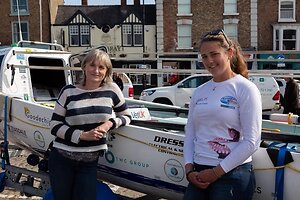March 2020 – by Ross Gemmell
Osteopathy, Physiotherapy and Chiropractic are three primary health care professions concerned with improving the physical well-being of patients, particularly as they overcome injuries, illnesses or disabilities.
Here at Northallerton Osteopaths we believe it is important for patients to have a good understanding of the difference between an Osteopath, a Physiotherapist and a Chiropractor before they choose which treatment option would be best for them. We believe it is helpful for patients to have an understanding of the three disciplines, their treatment goals as well as their treatment approach which is why we have put this guide together for our patients to read..
Osteopathy
What is Osteopathy?
Osteopathy is the recognized and established science of human mechanics; a system of diagnosis and treatment which lays the main emphasis on the structural and mechanical problems of the body. It primarily focuses on the musculoskeletal system, but does offer help for some circulatory and digestive problems.
Osteopaths believe in a holistic approach to healing and endeavor to find the cause of a problem. They believe that all bones, muscles, ligaments and connective tissues must work harmoniously together. As a result they often treat the neighbouring joints and structures to the problem, not just where pain is. They believe in treating the patient as a whole rather than treating only the symptoms.
Osteopathy Degree
To be an Osteopath, you have to have undertaken a 4-5 year Osteopathy university degree and be registered with the General Osteopathic Council (GOsC). Some Osteopaths complete an undergraduate degree before doing their 4-5 year Osteopathy degree.
What can an Osteo help with?
Back Ache
Back Pain
Sciatica
Arthritic Pain
Muscle Spasm
Muscle tension and inability to relax
Joint Pain
Shoulder Pain
Headaches arising from the neck (cervicogenic)
Migraine prevention
Hip Pain and Knee Pain from Osteoarthritis
Elbow Pain
Tennis/Golfer’s Elbow
Frozen Shoulder
Generalised Aches and Pains
Lumbago
Neuralgia
Fibromyalgia
Digestive problems
Circulatory problems
Rheumatic Pain
Cramp
To Aid Relaxation
How does an Osteo work?
Due to their training, Osteopaths are highly skilled in their sense of touch, otherwise known as ‘palpation’. Where other health care practitioners may rely on diagnostic measures such as X-Ray and MRI scans, Osteopaths often rely on their sense of touch to diagnose and treat patients. Osteopathy is very much a hands-on profession, treatments vary from patient to patient but may include.
- Soft tissue massage
- Joint articulation with varying degrees of subtlety
- Rhythmic stretching
- Joint manipulation
- High-Velocity-Thrust manipulation (HVT)
- Muscle Energy Technique (MET)
- Exercise prescription
Physiotherapy
What is Physiotherapy?
Physiotherapy, also known as ‘Physical Therapy’ is the physical approach to promote, maintain and restore physical health. Physiotherapy aims to restore movement and function when someone has been affected by illness, injury or disability.
Physiotherapy is a treatment where the patient is encouraged to participate in his or her care through physical exercise.
Physiotherapy Degree
To be a Physiotherapist it is usually a 3 year undergraduate Physiotherapy degree at university. However you can do a 2 year postgraduate Physiotherapy degree if you have a degree in a relevant subject such as; Sports Science, Biological Science or Psychology. To practice Physiotherapy in the UK, by law you must be registered with the Health and Care Professions Council (HCPC).
What can a Physio help with?
Broadly speaking, physiotherapy aims to improve conditions that affect the following four systems of the body.
- Neurological (Stroke, Parkinson’s disease, Multiple Sclerosis)
- Musculoskeletal (Back pain, Muscle pain, Fractures, Post-Operative)
- Cardiovascular (Cardiovascular diseases, Heart attack, Stroke)
- Respiratory (Asthma, Cystic Fibrosis, COPD)
How does a Physio work?
Physiotherapists will work with their patients in a number of ways;
- They will offer education and advice to the patient
- They encourage the patient to participate in his or her care through physical exercise and prescribed exercises
- They may treat patients actively through manual therapy & other techniques
Education and advice
Physiotherapists can play a key role in the management of conditions affecting the Neurological, Cardiovascular, Musculoskeletal and Respiratory Systems as they offer education and advice. Prescribed exercises and lifestyle management would also be included in the education and advice offered by a physiotherapist.
Manual therapy
Whilst it is less common for a NHS Physio to offer hands-on manual therapy, some Physiotherapists still use manual therapy to mobilise the soft tissues of the body. The end goal is to relieve pain and stiffness, improve general circulation, promote motivation and ensure relaxation.
Some Physiotherapists may undertake additional specialist training to perform thrust manipulations to the spine, however for Osteopaths and Chriopractors this training is included in their 4 year university degrees.
Other Techniques
- Acupuncture (Dry Needling)
- Electrical nerve stimulation
- Ultrasound
Chiropractic
What is Chiropractic?
Chiropractic treatment typically focuses on the patient’s spine and most people will seek out a Chiropractor for problems with their back.
The philosophy of Chiropractic treatment is that joint misalignment causes back pain as it compromises the body’s central nervous system. Chiropractors are therefore concerned mostly with the position of joints and often use diagnostic tools such as X-Ray and MRI scans assess this.
Chiropractic Degree
To be a Chiropractor you must have undertaken a 4 year Chiropractic university degree and be registered with the General Chiropractic Council (GCC).
What can a Chiro help with?
Chiropractic treatment is similar to Osteopathy as they are both manual treatments. Chiropractors sometimes use massage to manipulate the body’s soft tissues but generally speaking they are mostly concerned with ‘adjustments’ to the spine. The Chiropractor may use moderate force while working on the bones and muscles around the spine. Chiropractors typically make spinal adjustments by performing short quick thrusts on the patient’s spine.
As with osteopathy and physiotherapy, your practitioner will also advise you on a range of diets, exercises and nutrition to help prevent a further recurrence of your condition.
As well as back, joint, hip and foot problems, it has been suggested that chiropractic therapy may be useful in the treatment of the following conditions.
- Headaches
- Migraine Prevention
- Tension and inability to relax.
- Uncomplicated mechanical neck pain
How does a Chiro work?
Treatment involves spinal manipulation, and a Chiropractor will often make small ‘adjustments’ to the position of the lumbar vertebrae to relieve pressure and alleviate pain. These adjustments are what cause the familiar cracking or popping noise associated with Chiropractic treatment, the audible ‘pop’ noises are caused by small pockets of gas in your joint fluid.
Chiropractors sometimes also use small hand-held tools to treat back and neck pain. The Activator Method involves using a small spring-loaded instrument called an Activator Adjusting Instrument that delivers a single thrust at the determined site to correct a malfunctioning joint.



